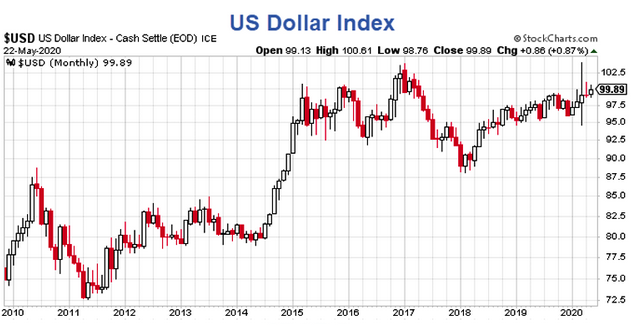
US Congress has authorized several trillion dollars in COVID-fighting stimulus programs. So what's holding the dollar up?
Think Outside The US
I remain amused by all the calls of hyperinflation and high inflation given the Fed has turned on the printing presses.
However, currencies cannot be viewed in isolation.
To those expecting a total US dollar collapse, here's my word of advice. Stop being so US-centric.
Japan Authorizes Another Trillion in Stimulus
Please note Japan authorizes another $929 Billion to Battle Pandemic.
Japan is considering a fresh stimulus package worth over $929 billion that will consist mostly of financial aid programs for companies hit by the coronavirus pandemic, the Nikkei newspaper said on Monday.
The package, to be funded by a second extra budget for the current fiscal year beginning in April, would follow a record $1.1 trillion spending plan deployed last month to cushion the economic blow from the pandemic.
That is a total of 2 trillion dollars for Japan. Adjusted for the relative size of the economies, that is an amazing amount.
China Unveils US$500 Billion Fiscal Stimulus
Also note that China unveils US$500 billion fiscal stimulus, but refrains from going all-in.
Key Points
- China will increase its budget fiscal deficit to a record 3.6 per cent of gross domestic product this year, up from 2.8 per cent in 2019
- This is the first time the ratio has exceeded 3 per cent – a red line for decades.
- Beijing will also issue special treasury bonds for the first time since 2007 and increase the local government bond quota as it fights the pandemic
Supposedly that is not "All In." And given what is going on elsewhere it isn't.
But the Yuan is not a component of the US dollar index. And it is important that China is crossing red lines.
Unprecedented EU Stimulus
On April 23, the EU leaders announced ‘Unprecedented’ Stimulus Against Pandemic.
Hold On, a Major EU Court Battle Brews
On May 10, I noted a Major Court Fight Between Germany and EU Looms
Briefly, the German constitutional court ruled that the ECB abused its powers ruling on the ECB asset purchases as implausible, and objectively arbitrary.
Debt Mutualization
What Germany fears now and has from the outset is "debt mutualization" in which Germany would bail out Greece, Spain, Portugal, and Italy.
And despite the German court ruling, Pablo Iglesias, Spain's Deputy PM. says a “certain [level of] debt mutualization is a [necessary] condition of the [continued] existence of the EU”.
Eurozone Breakup Risk
The EU once again faces a breakup crisis.
This setup prompted my May 8 post: Eurozone Breakup Risk at New High
With negative interest rates in the Eurozone and a breakup risk high and rising, it's no wonder the Euro is not strengthening.
US Dollar Index
The US Dollar Index is a weighted geometric mean of the dollar's value relative to following select currencies: Euro (EUR), 57.6% weight. Japanese yen (JPY) 13.6% weight. Pound sterling (GBP), 11.9% weight. Canadian dollar (CAD), 9.1% weight. Swedish krona (SEK), 4.2% weight. Swiss franc (CHF) 3.6% weight.
US Negative Rates Are Not an Option
Given the US dollar index weighting, it's no surprise the dollar is holding up.
Factor in Fed pledges to not let interest rates go negative, and a huge emerging market demand for dollars and you have your answer.
For a discussion of negative rates, please see Negative Rates Are Not an Option.
Meanwhile given all this competitive currency debasement, I have a question: Got Gold?
